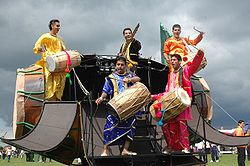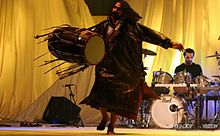- Dhol
-
This article is about the musical instrument. For the 2007 Priyadarshan movie, see Dhol (2007 film).
Dhol 
Other names ઢોલ,ਢੋਲ,ڈھول , ढोल, ঢোল, Դհոլ, دهل Classification Percussion instrument Playing range Bolt tuned Related instruments dholak More articles Bhangra, Bihu, Qawwali The dhol and also dohol (Persian: دهل), is a drum (a percussion musical instrument) widely used in the Indian subcontinent, especially the Punjab region and Gujarat. This insturment is from Northern India, Dhol has been adapted into the music of other regions throughout South Asia and abroad including the Armenia, Assam Valley (during Assam's Bihu festival), Rajasthan, Sindh, Maharashtra and Pakistan. It is very popular in modern Punjabi music.The dhol is normally and most commonly used in Bhangra music (a traditional celebration music used in the Punjab area in India and Pakistan.)
Contents
History
The dhol is a drum that dates back to the 15th century. It was probably introduced to the Indian subcontinent via the Persian drum type dohol (duhul).[1] The evidence for this is found in Ain-i-Akbari, which describes the use of duhul in the orchestra of the Mogul emperor Akbar.[2] The Indo-Aryan word "dhol" appears in print around 1800 in the treatise Sangitasara.[3]
Importance to regional traditions
Assam
In Assam, Dhol is widely used in Rongali Bihu (Bohag Bihu), the most beloved festival of the Assamese people. Rongali Bihu is celebrated in the mid of April every year.
Bengal and Bangladesh
Goa
During the Shigmo/Holi festival).
Gujarat
The dhol was used by Gujaratis during celebrations such as Navaratri to accompany garba. Garba are the folk songs which describe the grace of the divine mother.
Maharashtra
In Maharashtra, Dhol is a primary instrument used in Ganesh Festivals. In the city of Pune students, working professionals, businessmen come together to form Dhol Pathaks or troups. Pune supposedly has the largest number dhols in India.
Pashtun areas
When doing Attan, the cultural Pathan/Pashtun dance, Dhol is the main musical instrument. Attan is done in accordance to the sound of the Dhol.
Punjab (India and Pakistan)
It was used in war by the Sikhs and later to celebrate successful harvests by landowners. This drum became the ground roots of modern Bhangra music.
In Pakistan, the beats of dhol have been a vital element in the ceremonies of the great Sufi mystics and their followers. The patterns of dhol have been developed to catalyze the mind of the devotee as is seeking spiritual trance.
In global culture
It has also become popular in other parts of the world due to South Asian diaspora. Dhol has been a popular musical instrument in both formal and informal dance performances for decades.
Description
The dhol is a double-sided barrel drum played mostly as an accompanying instrument in regional music forms. In Qawwali music, the term dhol is used to describe a similar, but smaller drum used with the smaller tabla, as a replacement for the left hand tabla drum. The typical sizes of the drum vary slightly from region to region. In Punjab, the dhol remains large and bulky to produce the preferred loud bass. In other regions, dhols can be found in varying shapes and sizes and made with different woods and materials (fiberglass, Steel, Plastic). The drum consists of a wooden barrel with animal hide or synthetic skin stretched over its open ends, covering them completely. These skins can be stretched or loosened with a tightening mechanism made up of either interwoven ropes, or nuts and bolts. Tightening or loosening the skins subtly alters the pitch of the drum sound. The stretched skin on one of the ends is thicker and produces a deep, low frequency (higher bass) sound and the other thinner one produces a higher frequency sound. Dhols with synthetic, or plastic, treble skins are very common.
The introduction of electronic devices such as tape recorders has led to a decline in the importance of dhol players in celebratory events. Nevertheless, dhol music still figures in the studio recordings of present day Raas/Garba and Bhangra music artists. A related instrument is the dholak or dholki.
Playing
The drum is played using two wooden sticks, usually made out of bamboo and cane wood. The stick used to play the bass side of the drum is a bit thicker (roughly about 10 mm in diameter) and is bent in a quarter-circular arc on the end that strikes the drum, the dagga. The other stick is much thinner and flexible and used to play the higher note end of the drum, the thili. The drum is slung over the neck of the player with a strap usually made up of ropes or woven cloth. The surface of the wooden barrel is in some cases decorated with engraved or painted patterns.
The most common rhythm played on the Punjabi dhol in the U.K. is known as the Chaal, which consists of 8 beats per measure.
See also
- Davul
- Indian musical instruments
- Bhangra
- Bihu
- Bihu dance
- Garba
- Nagara (drum)
- Pappu Sain
- Punjab region
- Dholi
- Dholak
References
- ^ Thakur 1996; Nabha 1998
- ^ DHOL KING OF THE PUNJABI INSTRUMENTS. Gibb Schrefler.
- ^ Tarlekar 1972: 74
Further reading
- Schrefler, Gibb Stuart. Signs of Separation: Dhol in Punjabi Culture. University of California, Santa Barbara, 2010.
Categories:- Membranophones
- Pakistani musical instruments
- Indian musical instruments
Wikimedia Foundation. 2010.

